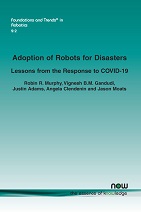Adoption of Robots for Disasters: Lessons from the Response to COVID-19
By Robin R. Murphy, Texas A&M University, USA, robin.r.murphy@tamu.edu | Vignesh B.M. Gandudi, Texas A&M University, USA, vigneshbabu.gm@tamu.edu | Justin Adams, Florida State University, USA, jadams@em.fsu.edu | Angela Clendenin, Texas A&M University, USA, clendenin@tamu.edu | Jason Moats, Texas A&M Engineering Extension Service, USA, Jason.Moats@teex.tamu.edu
Abstract
This article describes how robot innovations are adopted during a disaster using the COVID-19 response both as a natural experiment and a case study. The article is based on an analysis of the R4ID dataset of 203 instances of ground and aerial robots in 34 countries explicitly reported in the press, social media, and scientific literature from January 24, 2020, to July 4, 2020, as being used due to the COVID-19 pandemic. While the reports do not provide sufficient detail to ascertain gaps in specific algorithms or specific subsystems, such as perception, manipulation, or autonomy, the size and the pervasiveness of the data permits examination of three questions: 1) how the need for a robot arises during a disaster, 2) whether those needs are met with existing technically mature robots, adapting existing robots, or innovating new robots, and 3) what are the major barriers to inserting robots into use during a disaster. The analysis utilizes a novel formal framework consisting of a sociotechnical work domain analysis, an extended demand analysis, and a rating of the technical maturity of each instance using the NASA Technical Readiness Assessment (TRA) ranking. The relative TRA of robots is compared by work domain and modality, followed by an in-depth examination of technically mature Heritage systems, which accounted for 74% of the 203 instances, modified Engineering Systems (13%), and New Systems accounting (13%). The data is also discussed in terms of a) demand pull versus innovation push, b) availability, c) suitability, and 4) risk, leading to a formal model of organization adoption of robotics during a disaster. The analysis shows that organizational adoption of robotics during a disaster embodies two of the four components of the Unified Theory of Acceptance and Use of Technology Model (UTAUT) (Venkatesh et al., 2003), specifically that adoption is primarily influenced by end-users’ expectations of performance and how much effort they need to expend to integrate into work processes, also known as suitability and risk. The data also suggests that a third component of UTAUT, facilitating conditions for adoption, occurs during disasters because regulations and acquisition policies may be waived. In addition, the data shows that the lack of availability of some models of existing robots due to low inventory, delays in delivery, or high purchase price facilitated conditions for the development and adoption of new, possibly less reliable, alternative robots. The analysis also shows that the the adoption of robots for a disaster, regardless of work domain, is the result of demand pull by the primary stakeholders, not an innovation push by roboticists, as the majority of missions were established prior to the disaster. The article concludes with four recommendations for roboticists pursuing disaster robotics: 1) work with stakeholders before a disaster to design robots to meet pre-existing established demands, 2) design robots or software that support multiple uses so that robots can be quickly and safely adapted, 3) engage in technology transfer to integrate robots into operational use prior to the disaster, conduct fundamental research into formal methods for projecting the risk of using the robot in terms of direct and indirect performance and consequences, and 4) conduct fundamental research in design and on demand manufacturing so as to increase the availability and functionality of low cost Heritage robots.
Adoption of Robots for Disasters: Lessons from the Response to COVID-19
This monograph describes how robot innovations are adopted during a disaster using the COVID-19 response, both as a natural experiment and a case study. While the reports do not provide full details to ascertain gaps in specific algorithms or specific subsystems, the size and the pervasiveness of the data permits examination of three questions, namely: how the need for a robot arises during a disaster; whether those needs are met with existing technically mature robots, adapting existing robots, or innovating new robots; and what are the major barriers to inserting robots into use during a disaster.
The analysis utilizes a novel formal framework consisting of a sociotechnical work domain analysis, an extended demand analysis, and a rating of the technical maturity of each instance using the NASA Technical Readiness Assessment (TRA) ranking. Also covered are related work in modeling the adoption of robots and prior summative of the use of robots for the coronavirus pandemic, as well as a novel framework for analysis is discussed in detail. An analysis is also made of all Heritage systems, Engineering systems, and New systems. The publication concludes with findings for disaster robotics, then uses the model of adoption to make four recommendations for roboticists interested in developing and deploying technology for a disaster.
This monograph provides an in-depth overview and practical examples of how robots can be deployed during a disaster. As such it should prove useful for roboticists, researchers in various fields related to robotics as well as industry professionals who are responsible for saving lives and mitigating societal impacts in times of disaster.
